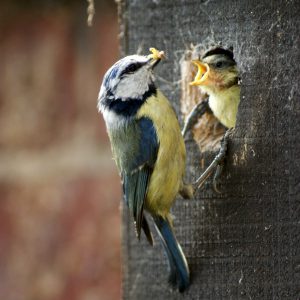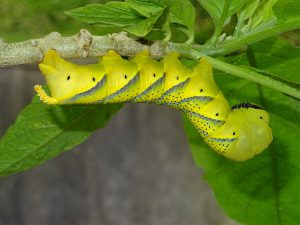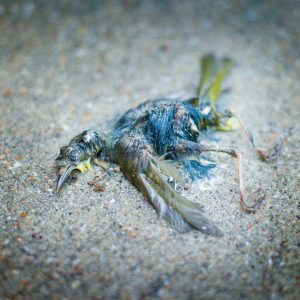
Birds Are Starving
Exotic (non-native) plants do not support the caterpillars that native birds need for food, causing birds to starve to death. If birds can’t find enough caterpillars, they can’t reproduce and they and their young starve.
Birds Need Caterpillars
Did you know that a chickadee that is the weight of 4 pennies must feed its young between 6,240 and 9,120 ca terpillars in just 16 days to get them to the fledgling stage? If you think you work hard, chickadees bring caterpillars to their chicks every 3 minutes from 6 AM to 8 PM. Did you know that 80 to 90% of a hummingbird’s diet is insects and spiders, and that this is true for 96% of land-dwelling birds?
terpillars in just 16 days to get them to the fledgling stage? If you think you work hard, chickadees bring caterpillars to their chicks every 3 minutes from 6 AM to 8 PM. Did you know that 80 to 90% of a hummingbird’s diet is insects and spiders, and that this is true for 96% of land-dwelling birds?
Why Caterpillars?
There are several reasons caterpillars are essential to birds. They are soft so they will not hurt the young chick’s throat, they are large, and they are very high in protein and fats needed for growth.

Caterpillars contain double the amount of carotenoids (nutrient) as other insects. Carotenoids stimulate the immune system, improve color vision and sperm viability, improve sexual attractiveness, are required by developing chicks, and are antioxidants.
 Life for birds, lizards, frogs, bears, fox and many other wildlife depends upon an abundance of insects as a food source. Native plants support the insects needed for bird and animal survival. A world without insects is a world without biodiversity (variety of life) and a world in which humans cannot survive. That is what makes this so important.
Life for birds, lizards, frogs, bears, fox and many other wildlife depends upon an abundance of insects as a food source. Native plants support the insects needed for bird and animal survival. A world without insects is a world without biodiversity (variety of life) and a world in which humans cannot survive. That is what makes this so important.
Use Native Plants
Native plants, animals and insects have evolved together for millions of years. Plants produce compounds that make them taste bad or cause sickness or death so they won’t be eaten. As insects evolved with plants, they found ways to overcome these compounds. Ninety percent of insects that eat plants can only eat the plants with which they co-evolved.

The monarch butterfly is able to feed on milkweed (which is poisonous) because it evolved to keep the plant from stopping its heart. Insects are usually able to overcome compounds in one type of plant, so they can only feed on that plant type. Exotic plants have not evolved with the native insects and therefore native insects cannot use them as a food source.
 Provide Diversity
Provide Diversity
Exotic plants may have one type of caterpillar which feeds on it compared to a native oak that can provide for 395 types of native caterpillars. Diversity is important: If one type of caterpillar is having a bad year that would mean no food at all. With a variety of caterpillars produced there will always be a food source for birds and animals. For a list of plants and the number of caterpillars they support visit https://www.nwf.org/NativePlantFinder/

Stop Using Pesticides
We have been conditioned to think we have to spray and kill insects in our gardens. New research, along with the increasing extinction of native flora and fauna, is teaching us otherwise. Insects are a critical part of the environment and our food webs. Birds and other animals will starve without insects and caterpillars to eat.
Going, Going, Gone…
 Birds need our help! Worldwide there are approximately 10,000 species of birds, with an estimated 1,200 considered to be under threat of extinction. Over 190 species of birds have become extinct, and this rate of extinction seems to be increasing. In 2014, 230 North American bird species were listed as “at risk of extinction”. Two years later that number had climbed to 426. In the U.S. there are 1.5 billion fewer breeding birds compared to 40 years ago. Forty-Six species have lost half of their population. Natural areas are too small and fragmented to sustain animal populations. Invasive exotic species have escaped our gardens and taken over natural areas further destroying much needed food sources.
Birds need our help! Worldwide there are approximately 10,000 species of birds, with an estimated 1,200 considered to be under threat of extinction. Over 190 species of birds have become extinct, and this rate of extinction seems to be increasing. In 2014, 230 North American bird species were listed as “at risk of extinction”. Two years later that number had climbed to 426. In the U.S. there are 1.5 billion fewer breeding birds compared to 40 years ago. Forty-Six species have lost half of their population. Natural areas are too small and fragmented to sustain animal populations. Invasive exotic species have escaped our gardens and taken over natural areas further destroying much needed food sources.
 You can help!
You can help!
Before it is too late for birds:
- Use native plants.
- Remove all invasive species.
- Replace exotic plants with native plants.
- Stop spraying insecticides in your yard.
- Replace bird feeders with plants that support caterpillars.
- Add a birdbath or pond.
- Plant a wildflower meadow.
- Ask nurseries and big box stores to supply mostly native plants.
- Keep cats indoors.
- Talk to your government representatives about preserving and increasing natural areas and providing wildlife corridors. Ask them to change landscape codes to include all native plants. Ask them to plant wildflower meadows instead of lawns.
Share this information with your family and friends. Birds’ lives depend on you. What you plant matters!
We can help you
 If you need help selecting plants for your landscape, we are here to help you. We are located at 12520 Ulmerton Road, Largo, FL. The University of Florida Lawn and Garden Help Desk (free) is available Monday-Friday from 8:00 AM to 4:30 pm. The Lawn and Garden Hotline (727-582-2110) is available Monday, Tuesday and Thursday from 9 am to noon and 1 to 4 pm. We also offer free and low cost classes, which are on our website: sfyl.ifas.ufl.edu/pinellas
If you need help selecting plants for your landscape, we are here to help you. We are located at 12520 Ulmerton Road, Largo, FL. The University of Florida Lawn and Garden Help Desk (free) is available Monday-Friday from 8:00 AM to 4:30 pm. The Lawn and Garden Hotline (727-582-2110) is available Monday, Tuesday and Thursday from 9 am to noon and 1 to 4 pm. We also offer free and low cost classes, which are on our website: sfyl.ifas.ufl.edu/pinellas
Resources
You can also visit the Florida Native Plant Society website and look for landscape plants at http://www.fnps.org/plants.
Reference and a great video to watch: Dr. Doug Tallamy: “Creating Living Landscapes to Restore Nature’s Relationships” https://www.youtube.com/watch?v=HbsAAwpP34E
 1
1


